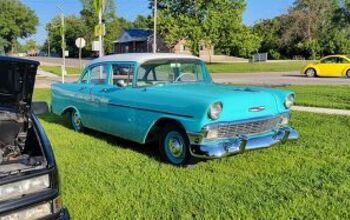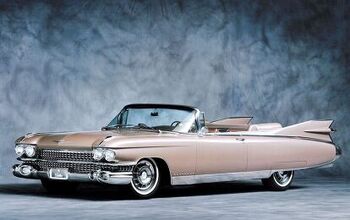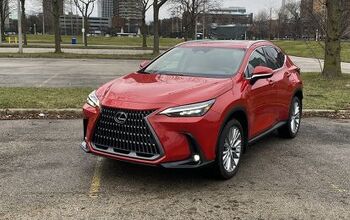Goodyear Recalls Tire Nobody Uses Anymore

Goodyear has agreed to recall more than 173,000 intended for commercial delivery vehicles and RVs nearly two decades after the last one was manufactured. The company’s G159 tires have been under investigation by the National Highway Traffic Safety Administration (NHTSA) since December of 2017 and the recall comes in the wake of years of lawsuits alleging the rubber contributed to a series of fatal accidents dating back to 1998.
Despite no new claims having launched in years, court orders and settlement agreements delayed an order to make corporate data pertaining to the tire-buying public for five full years. The NHTSA didn’t even launch a formal investigation until late in 2017, followed by the recent announcement that the agency has pushed Goodyear into a recall for a tire that ended production during the Bush administration.
Manufactured between 1996 to 2003, the tires were eventually supplanted by the G159A after criticisms began to turn into lawsuits. According to the Associated Press, some of the initial lawsuits alleged that the tires were designed specifically for delivery trucks and were never intended for use by recreational vehicles traveling long distances at sustained highway speeds. Though the real issue seems to be that Goodyear was repeatedly accused of intentionally trying to obfuscate the matter while hiding any internal data that would support those claims via settlement agreements.
It wasn’t clear how many potential fatalities the G159 tires were involved in until after the NHTSA launched its investigation. By 2018, the number was estimated to be 95.
From AP:
Goodyear Tire & Rubber Co., based in Akron, Ohio, denied that the tires have a safety defect and said Tuesday that few, if any, are still on the road. The company said it’s doing the recall to address risks that happen when the tires are underinflated or overloaded on motorhomes.
“This tire hasn’t been made since 2003, it consistently met Goodyear’s demanding safety standards, and we have not received an injury claim related to the tire’s use on a Class A motorhome in more than 14 years,” Goodyear said in a prepared statement.
Documents show that the government safety agency sent Goodyear a letter requesting a recall of the 22.5-inch diameter tires on Feb. 22 of this year, and the company declined the request on March 8. But Goodyear later agreed to the recall “to address concerns that some of these tires may still be in the marketplace or in use.”
NHTSA must hold a public hearing and then go to court to force a company to do a recall.
Considering how few are probably left on the road, Goodyear has opted to replace G159 tires with a newer model at no cost to RV owners. Those using the tire on other vehicles will be allowed to exchange them for $500 (which wouldn’t quite cover the cost of the newer G159A).
But it’s unlikely to get a lot of takers as anybody who is keeping a set of 19-year-old tires on their vehicle has probably been killed already. Joking aside, rolling around on a set of rubber that’s old enough to drink in some countries is a terrible idea and it’s doubtful there will be many people taking advantage of this particular recall. Goodyear even noted that the RV companies that used the G159 as factory rubber aren’t even in business anymore — making it difficult for it to acquire the relevant registration data as a way of contacting impacted owners. It also added that they would have been the ones responsible for communicating to customers what the appropriate load limits should be.
Meanwhile, the NHTSA is making itself look busy by issuing statements to the public to check if their RV or delivery vehicle uses G159 tires sized for a 22.5-inch rim. It said it believes the units yield a comparatively high failure rate vs similar tires — though just about every tire their age probably would at this point.
“If their vehicle has these tires, they should have this recall completed as soon as possible,” the NHTSA stated.
I’m not sure what the big takeaway for this one is beyond widespread embarrassment. Assuming the tires were bad news from the start, Goodyear does seem to have gone well out of its way to hide any data that would back up assertions the G159 was dangerous. Meanwhile, the government seemed to be largely incapable or disinterested in taking the regulatory actions necessary to get them off the road in a timely fashion. Again, the NHTSA’s formal investigation didn’t really pick up steam until 2018 and only just managed to result in a comprehensive recall for a bunch of tires that aren’t even in use anymore.
[Image: GVLR/Shutterstock]

A staunch consumer advocate tracking industry trends and regulation. Before joining TTAC, Matt spent a decade working for marketing and research firms based in NYC. Clients included several of the world’s largest automakers, global tire brands, and aftermarket part suppliers. Dissatisfied with the corporate world and resentful of having to wear suits everyday, he pivoted to writing about cars. Since then, that man has become an ardent supporter of the right-to-repair movement, been interviewed on the auto industry by national radio broadcasts, driven more rental cars than anyone ever should, participated in amateur rallying events, and received the requisite minimum training as sanctioned by the SCCA. Handy with a wrench, Matt grew up surrounded by Detroit auto workers and managed to get a pizza delivery job before he was legally eligible. He later found himself driving box trucks through Manhattan, guaranteeing future sympathy for actual truckers. He continues to conduct research pertaining to the automotive sector as an independent contractor and has since moved back to his native Michigan, closer to where the cars are born. A contrarian, Matt claims to prefer understeer — stating that front and all-wheel drive vehicles cater best to his driving style.
More by Matt Posky
Latest Car Reviews
Read moreLatest Product Reviews
Read moreRecent Comments
- Redapple2 4 Keys to a Safe, Modern, Prosperous Society1 Cheap Energy2 Meritocracy. The best person gets the job. Regardless.3 Free Speech. Fair and strong press.4 Law and Order. Do a crime. Get punished.One large group is damaging the above 4. The other party holds them as key. You are Iran or Zimbabwe without them.
- Alan Where's Earnest? TX? NM? AR? Must be a new Tesla plant the Earnest plant.
- Alan Change will occur and a sloppy transition to a more environmentally friendly society will occur. There will be plenty of screaming and kicking in the process.I don't know why certain individuals keep on touting that what is put forward will occur. It's all talk and BS, but the transition will occur eventually.This conversation is no different to union demands, does the union always get what they want, or a portion of their demands? Green ideas will be put forward to discuss and debate and an outcome will be had.Hydrogen is the only logical form of renewable energy to power transport in the future. Why? Like oil the materials to manufacture batteries is limited.
- Alan As the established auto manufacturers become better at producing EVs I think Tesla will lay off more workers.In 2019 Tesla held 81% of the US EV market. 2023 it has dwindled to 54% of the US market. If this trend continues Tesla will definitely downsize more.There is one thing that the established auto manufacturers do better than Tesla. That is generate new models. Tesla seems unable to refresh its lineup quick enough against competition. Sort of like why did Sears go broke? Sears was the mail order king, one would think it would of been easier to transition to online sales. Sears couldn't adapt to on line shopping competitively, so Amazon killed it.
- Alan I wonder if China has Great Wall condos?


































Comments
Join the conversation
No offense intended to anyone, but I have always been of the belief and experience that any Goodyear tire that doesn't have the name EAGLE on it is junk.
Goodyear slowed and obscured the safety data until they knew these tires were largely out of service in order to reduce the recall costs. They have known for 20 years that these tires were defective and not suitable for use in the applications they chose to sell to RV Manufacturers. They knew it was not a safe design for RV's but they kept selling it anyway. When the blowouts started, they blamed the owners, and when their internal tests and reports showed a problem, they delayed and obscured in order to minimize the costs AND litigation. It's much easier to settle the case and not admit fault PRIOR to issuing a recall. That's why they did the recall AFTER the tires were not on the road and the cases are largely settled out. If you follow the articles and court documents, you will never want to buy or ride on a goodyear product again. https://www.consumerreports.org/product-safety/goodyear-rv-tire-linked-to-multiple-deaths-is-still-on-motorhomes-a1197423360/